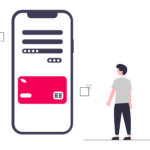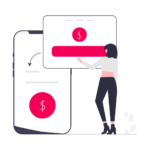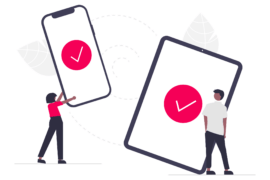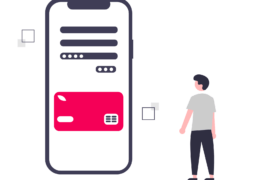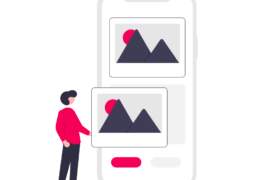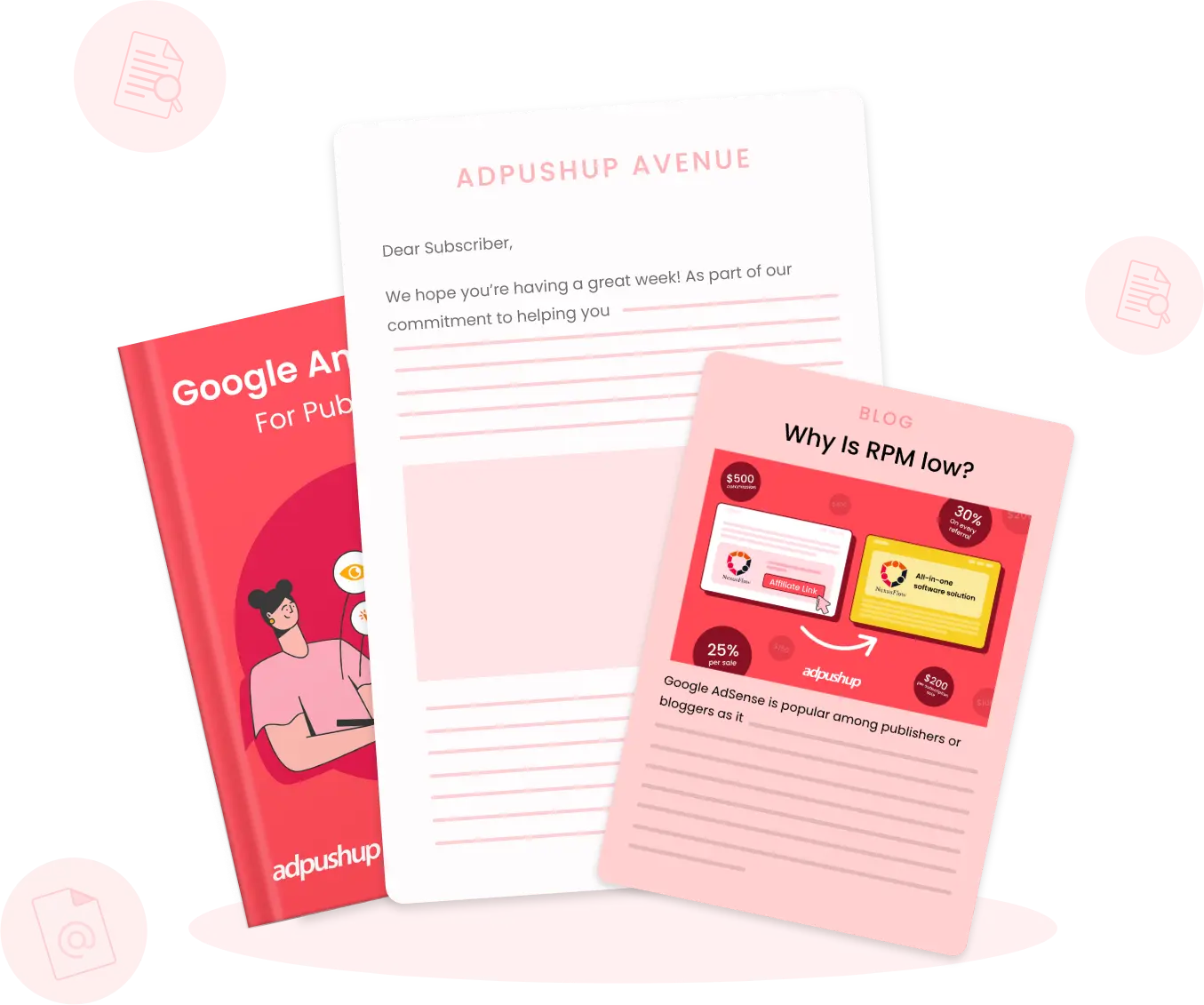App monetization strategies, if executed flawlessly, can make you a bank. Some of the models include in-app advertising, data licensing, and in-app purchases.
Building an app is just half of the battle won. The real game is figuring out an app-pricing model without turning off your users. App monetization strategies aren’t limited to turning downloads into dollars anymore. Its north star is to create a sustainable app ecosystem that sustains your business in the long run.
Whether you are an indie developer or an established app publisher, our 12 best app monetization ideas will strike a chord with you. But before that, let’s brush up on our basics.
What is App Monetization?
App monetization, as the name suggests, is the process of generating revenue from the app to create a long-term sustainable ecosystem for the application.
Let’s get to the top app monetization strategies for a publisher-focused, revenue-driven 2025.
The smartest app developers in 2025 don’t treat monetization as a post-launch feature. They integrate it into their product thinking from day zero — testing formats, optimizing placements, and iterating based on live data. With rising CPIs and stricter ATT policies, you simply can’t afford to ‘add monetization later’. Revenue strategy needs the same rigor as UX or retention.
Utkarsh Pandey, Associate Product Manager | AdPushup
12 Best App Monetization Strategies for 2025
1. In-app Advertising (IAA)
In-app advertising is one of the most popular app monetization options among app publishers. It provides an immense opportunity for publishers to monetize the app without placing a monetary burden on the users.
According to Statista, ad spending in the global in-app advertising market is expected to reach $390.04 billion in 2025. Furthermore, it will have an annual growth rate (CAGR 2025-2039) of 8.17%, resulting in a predicted market volume of $533.92 billion by 2029.
Moreover, in-app advertising has a lot of scope for app publishers to dive into and explore its options. As the in-app advertising market is yet to reach the consolidated stage, app publishers can explore various in-app ad players to choose the one that fits their requirements.
In-app ads are carefully created to integrate into the app’s UX and complement the user experience. Their strategic placements ensure that users don’t see the ads as disruptive and are amicable to them. As a developer or a publisher, you must be mindful of executing in-app advertising lest it lead to multiple app uninstallations.
In-app Advertising Ad Formats
There are multiple ad formats that you can utilize for successful in-app advertising, such as:
- Digital billboard ads: An in-game advertising format, the non-interruptive virtual billboard ads are ideal for targeting hard-to-reach audiences. These ads are generally placed in multiplayer games that offer real-life virtual setups, such as Call of Duty, PUBG, and Fortnite.
- Interstitial ads: A popular format for in-app advertising, these ads are placed during natural transitions within an app. Advertisers are willing to pay more for interstitial ads as they consistently outperform other formats in capturing user attention, leading to higher eCPMs.
- Rewarded video ads: This ad format is a market favorite, especially within the online gaming industry. As the name suggests, rewarded ads reward users with coins or app-specific rewards upon watching video ads. Being user-initiated ads, users are less likely to feel frustrated while watching them, making them complete the ad.
Are you an app publisher seeking app monetization? Contact AdPushup. We offer VAST Tags for rewarded video ads where SDK integration isn’t feasible. Apart from gaming apps, the plug-and-play VAST tags can also be embedded in OTT players to access free-filtered, brand-safe demand.
- Native ads: These ads are best suited for smooth-flow aficionados who are not willing to compromise the user experience. Native ads are designed to blend with the app’s surroundings to negate any negative user experience. These ads are generally placed in premium ad slots as they command higher eCPMs.
- Playable ads: A digital version of “try before you buy” for apps, the HTML5 mini-experience was launched as a subset of interactive ads to enhance user engagement. These ads are predominantly utilized to advertise other gaming apps within an app. With playable ads, the user can play a simplified version of the game within an app, increasing user retention.
Ad Partners and SDK
App publishers collaborate with programmatic advertising entities like ad networks, ad exchanges, or ad tech partners to execute in-app advertising. However, the SDK of many ad partners in the market come with heavy integration requirements. Such requirements can overwhelm the app publishers as the integration can take weeks to finally set up and perform. On top of it, regular updates from these SDKs require active maintenance.
Not to mention, different SDKs provide different functionalities. Also, managing multiple SDKs can be very tedious. Let alone managing them, multiple SDKs add weight to your app and hurt ad performance, reducing user engagement. Thus, it’s recommended for app publishers to incorporate a single SDK that serves all their needs.
AdPushup’s Single Mobile SDK to Ace App Monetization
That’s where AdPushup comes in. A Google-certified publishing partner, AdPushup offers all-around in-app advertising solutions using advanced capabilities to scale your app business. AdPushup’s SDK wrapper is a unified, lightweight SDK that gives you access to premium demand, smarter monetization logic, and built-in analytics, all without the typical SDK overhead.
It comes with various modules to suit the developer’s use case. Moreover, our SDK integrates well with all available platforms like iOS, Android, Linux, Windows, and CTV/OTT for scalability across all devices.
In addition to conventional ad formats (display/video/banner/native/rewarded) for mobile apps, we also offer WebView ads for operating systems apart from Android and iOS, and CTV SDK for Android CTV.
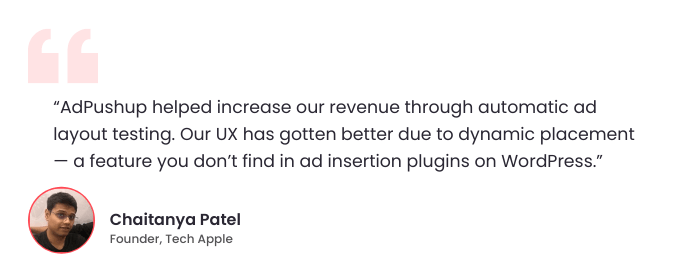
2. Download Fees
The download fees model is one of the simplest mobile app monetization models. It requires no in-app purchases, no subscriptions, and no ads!
Here, unlike the subscription model, the user has to pay a one-time or download fee to access all the app features. In such models, the revenue is directly tied to the number of active users. The apps usually offer a trial period before asking for payment to continue enjoying the features.
While some apps like Things 3 have successfully pulled off this model, it is not easy to replicate, especially when a host of free options are available. For the download fees model to work, your app must provide a unique offering to entice users to pay.
3. Subscription-based Models
Talking about the most sustainable monetization model, subscription-based monetization is another popular strategy employed by many large-scale app publishers. By 2025, the subscription revenue from media and digital content will touch $1.26 trillion, growing by over CAGR 13.5% (Statista).
Subscription allows users access to premium content or features within an app for a recurring fee. The payment cycle can be weekly, monthly, or even yearly. There are multiple subscription-based monetization models that app publishers can implement, such as:
Premium/flat-rate Subscription
Premium subscription-based apps require users to sign up for a plan upon downloading the app. Premium subscribers guarantee a consistent revenue inflow, which can work towards scaling up the application.
This model is especially popular among streaming apps like Netflix, where users have to sign up for a plan to start watching the content.
Freemium Subscription
The next one is the freemium subscription, a fan favorite among users and publishers. Consider a freemium subscription to be the digital equivalent of free tasting at ice cream parlors. Users don’t have to pay to use the basic features, but upgrading would be required to access the gated features.
This subscription model provides access to a wider user base than premium subscriptions. Moreover, you can even generate revenue from users who are yet to subscribe.
Music apps like Spotify and news apps like The Washington Post or The Wall Street Journal follow the freemium model.
Tiered Subscription
A tiered subscription is another model similar to the above two. Here, the app offers multiple subscription plans with varying prices and features to cater to a diverse customer base. This allows users to choose a package that best fits their requirements.
Apps like Canva, Grammarly, MailChimp, and even Netflix follow the tiered subscription model. Canva, Grammarly, and MailChimp offer varied subscription packages based on the usage – individual, team, or enterprise level with varying features at each level. On the other hand, Netflix’s offers are based on the number of screens/users.
Usage-based Subscription
Usage-based subscriptions can be seen in apps that offer storage facilities, like DropBox, Google Drive, and even Apple Cloud. The revenue is directly tied to the usage level. The more the user utilizes the features, the more revenue will be generated.
Cloud storage apps offer different storage levels, which the user can choose from and pay a recurring fee to keep using.
Bundle Subscription
A bundle subscription is a type of subscription that offers more than one product in a single package, usually at a discounted price. Amazon Prime, Microsoft 365, and Google Suite are worthy examples of bundle subscriptions.
It allows app publishers or developers to diversify their offerings to increase the value proposition of their package. Moreover, such subscriptions also make it more amicable for users to pay for the subscription.
4. App Transaction Fees/Commissions/Service Fees
If your app connects users with certain services or facilitates transactions, incorporating commissions as a part of your app monetization strategy will allow you to tap into scalable revenue streams.
This app monetization strategy allows you to charge users a fee for facilitating interactions, such as processing payments, offering premium features, or improving the overall user experience.
Examples include stock trading apps, Uber, Airbnb, and Upwork.
5. In-app purchases (IAP)
If you are a game app publisher, IAP is the best money-making bet for you on the table. IAP entails selling virtual products, services, or gated features to the users within the app to enhance user engagement and satisfaction. Many app publishers offer in-app purchases to allow users to curate their app-surfing experience according to their personal preferences.
IAP is also the most favored monetization model in the Apple App Store (Statista).
The in-app purchase (IAP) market has seen exponential growth in recent years, driven by the evolution of mobile ecosystems and app monetization trends. Valued at $209.13 billion in 2024, the market is projected to reach $257.23 billion by 2025, reflecting a compound annual growth rate (CAGR) of 23.0%. By 2029, it is expected to surge to $657.18 billion, accelerating at a CAGR of 26.4% (The Business Research Company).
In-app purchases are categorized into two parts:
- Consumables: Temporary purchases like in-app tokens or currency, health upgrades, or game passes to unlock premium features.
- Non-consumables: One-time permanent purchases like unlocking a premium character in a game, paying to remove ads, or customizations.
An example of this revenue model can be seen with Township, a farming and city-building game that offers various passes, like the Golden Ticket and Flower Pass, to unlock premium features within the app.
6. App Re-skin by Creating a Strong Code
As an app publisher, putting extra effort into creating a strong code can open up new monetization opportunities. If you create a code from scratch and it becomes successful, you can get re-skinning offers from other brands.
In software development, reskinning is a process where new visuals are added to the existing software application while retaining its original functionality.
The best example of reskinning is the popular game Temple Run — to create Temple Run Oz. It was a marketing collaboration between Disney and Imangi Studios to promote the former’s new movie — Oz: The Great and Powerful.
7. Brand Sponsorship and Partnership
Both sponsorships and partnerships are exceptional app monetization models to drive app revenue. However, there is a fine line of difference between the two.
In-app sponsorship is an advertising technique where the brand sponsors an app in exchange for promotion and visibility. Brands can simply display ads or leverage the app functionalities to promote itself. One top example is Subway sponsoring the PrePlay football game application to engage with sports enthusiasts during the Super Bowl XLVI.
On the other hand, partnerships take collaboration to the next level. Compared to sponsorship ads, partnerships focus more on long-term relationships with the brand. The partnership is essentially a barter: both parties gain something from the collaboration in kind.
Take Nike and Apple. The sports brand created the Nike+ app for the Apple Watch to combine Nike’s athletic expertise with Apple’s product ecosystem.
8. App Data Licensing
Data is the new currency. So, why let the digital dust settle when you can cash it? Apps collect consented user-generated data, which turns into a data gold mine over time. This data repository can be crunched and sold to brands and advertisers to provide in-app user insights. Advertisers utilize these insights to place ads on the app or enrich their existing user database.
Data monetization is a win-win situation for all: Advertisers get to advertise, apps get paid, and users get free access.
Let’s address the elephant in the room: Data privacy.
It is legal to collect user data and share it with third parties. However, users should be made aware of how and where the data will be used. Also, the collected user data has to be signed off by the user. Secondly, the data has to be shared in an anonymized form to maintain user privacy.
A great example of this app revenue model is Waze, a navigation app that sells anonymized user-generated data to advertisers looking to serve hyperlocal ads.
9. Affiliate Marketing
Affiliate marketing is one of the most widely adopted mobile app monetization strategies to ensure long-term growth through referral-based revenue. As per Clickadu, mobile devices account for around 62% of all affiliate-driven traffic.
A survey by Rakuten Advertising found that 84% of publishers and 81% of advertisers have leveraged affiliate marketing into their monetization models.
Numbers speak for themselves. According to AuthorityHacker:
- The global affiliate marketing sector is anticipated to reach $27.78 billion by 2027.
- Affiliate marketing accounts for 5% to 25% of major brands’ total internet sales.
- Affiliate programs are the most essential client acquisition strategy for 40% of US businesses.
- 44% of brands employ first-interaction attribution in their affiliate marketing activities.
Moreover, almost all the major apps a user uses daily are into affiliate marketing — Shopify, Amazon, Notion, Robinhood, and Booking.com, to name a few.
10. Email Marketing
If you think email marketing has no place in this list, you couldn’t be more wrong. According to Forbes Advisor, 88% check their mail daily, 61% spend 8 seconds or more on each message, and 41% of email views come from mobile phones.
Knowing how effective email marketing is, many brands, whether old or new, continue to invest in this vertical to drive conversions. But how can a publisher utilize email as one of the app monetization strategies?
You can use emails to either announce app discounts and lucrative deals, update the users with new app offerings, or simply engage them via newsletters to retain them.
11. E-commerce Integration
App publishers can also embed e-commerce functionalities to let users shop directly from their app. It sounds easy, but involves a complex setup on the backend to maintain data consistency.
Instagram has enabled e-commerce integration via features like Instagram Shopping, Product Tagging, and Instagram Checkout. Through this, brands can directly sell their products within the app sans a separate website. Shopify also offers e-commerce integration with Instagram to manage online business and social media presence from one dashboard.
12. App Store Optimization
Having a strong first impression can increase conversions by 35%. However, only 10% of Google Play Store and Apple App Store visitors view and, presumably, read all of the sites’ material. (LLCbuddy)
Here comes App Store Optimization (ASO) — a prominent mobile app monetization strategy to improve app visibility on various app stores.
It’s just like SEO but for apps! Like SEO, ASO ranks your app in app stores for a search query to increase organic downloads.
Optimizations under ASO include:
- Choosing relevant keywords to rank the app for the search query
- Curate compelling app descriptions that include all the related keywords the user may use to find the app
- Add engaging visuals like app screenshots, videos, or icons to attract users
- Descriptive yet click-worthy app title
- Conversion rate optimization by making the app listing page as simplified as possible to encourage downloads
ASO is based on years of study of user interaction with applications. Take a look. The first 252 characters of your app description are the most critical, as that’s the portion users are most likely to read first. So, under ASO, app publishers should utilize this space to highlight their app’s USP.
Similarly, listings that include a video drive over 25% more installs by encouraging users to explore the experience rather than making quick, uncertain decisions. (LLCbuddy)
Now that we have covered app monetization strategies, let’s understand how to choose the best one for you.
Which of the Mobile App Monetization Strategies is Best For You?
Choosing the best app monetization strategy for your business seems easier than it is. It isn’t a mere checkbox, it is a strategic decision that will impact your app’s scalability, user retention, and revenue in the long run.
We have enlisted some factors that you should consider when adopting a mobile app monetization strategy.
App’s Core Functionality
What does your app do? Or, what solution does your app offer? An analysis of your app’s offerings can play a part in defining your app monetization model.
For example, Freemium models work best for music streaming apps like Spotify, while Premium subscriptions work well with OTT apps like Disney+ and Hulu. In contrast, gaming apps conventionally opt for in-app advertising and in-app purchases, mainly for user retention.
Target Audience
What does your user want out of your app? Who will benefit from your app? And are they willing to pay? As an app publisher, an in-depth study of your user demographics and behavior will build your chain of thought.
Younger audiences may prefer free access to apps with an option to upgrade. However, businesses or corporate professionals may want a polished ad experience and be open to subscriptions. At the same time, gamers tend to be open to in-app purchases or even in-app advertising.
Long-term Vision
Where do you see your app in the next 2-5 years? Your monetization strategy should align with the roadmap you have set for your app business.
Subscription models will best suit you if your goal is predictable, recurring income. A consistent income stream will allow you to scale your app in stages.
But if user acquisition and rapid scaling are your goals, then freemium or ad-supported models may work in your favour to reduce entry barriers and grow your user base quickly.
5 Actionable App Monetization Best Practices
Curating an ad monetization strategy involves a behemoth data sifting to maintain the essence of the app. A well-thought-out app pricing strategy not only communicates the app’s value but also reinforces your app’s market positioning.
Here are some best practices that you can apply to your monetization strategy to balance profitability with user experience:
Competitive Analysis
Run an in-depth competitor analysis. Begin by evaluating their app monetization strategies and analyzing what makes them stand out. Ask yourself: why is the competitor’s app minting money with a subscription-based model or an in-app purchases model? Why didn’t the app go with in-app advertising or data licensing?
If your competitors offer freemium models, it’s well understood that offering premium models will automatically limit your entry into the market. However, if you opt for in-app advertising, the tables can turn in your favor.
Stay Compliant with Privacy Regulations
If you plan to monetize your app via data licensing or in-app advertising, this is especially for you. Ensure you comply with major privacy laws like CCPA, GDPR, DPDPA, and platform-specific privacy norms.
Maintaining transparency will build trust in your users and keep legal complications at bay.
Offer Localized Pricing Options
If the advertising is hyper localized, then your pricing needs to be localized as well. A thorough study of target demographics will bring some clarity into your thought process.
Plus, there’s no such thing as a one-size-fits-all strategy. Each region perceives a given value differently. For example, Netflix’s pricing in the USA will certainly not work in India.
As we say, what plays in Peoria might not play in Pune.
Minimize Tech Debt with Scalable Infrastructure
Keeping your tech infrastructure simplified will do wonders in the long run. How? It will make your app’s scalability easy to implement and achieve.
Use lightweight SDKs or a unified SDK that reduces overheads and simplifies ad serving, subscription management, or analytics tracking.
The best example is AdPushup’s Mobile SDK, which is simple, easy to integrate, and offers room for rapid expansion while maintaining the UI/UX.
Diversify Revenue Streams
It’s wise never to put your eggs in one basket. Diversify your monetization strategy by combining various pricing models. As each pricing model serves a particular purpose, combining more than one model will cover more touchpoints.
Key Takeaways – App Monetization Strategies
App monetization: It is the process of creating a revenue stream from an app.
App monetization strategies: In-app advertising, Data monetization, Brand sponsorships and partnerships, In-app purchases, Subscription models (freemium/premium), and App store optimization.
Factors for choosing the best app monetization method: App’s core functionality or offering, target audience, and long-term vision.
App monetization best practices: Do a thorough competitive analysis, offer localized pricing options, stay compliant with privacy regulations, diversify revenue streams, and minimize tech debt with scalable infrastructure.
Maximize ad revenue with minimal effort. AdPushup’s publisher-first monetization stack gives you fast integrations, premium demand access, and transparent insights — all without overhauling your app.
Fill the form and book a free demo!
FAQs – Mobile App Monetization Strategies
An app monetization strategy is a clear plan to monetize an app to create a scalable environment for future developments within the app.
There are many ways to make money from apps without ads, such as app data monetization, brand partnerships, in-app purchases, and subscription models, among others.
Both developed by Google, AdMob is specifically for app publishers, while AdSense is predominantly for website publishers.
In-app purchases are the primary monetization strategy for apps on the Apple App Store.
In-app advertising is the most popular way to monetize apps on Google Play Store. However, a plethora of monetization options are available, such as app store optimization, affiliate marketing, brand sponsorship ads, etc.
There are various mobile app monetization models, such as:
– Download fees
– Transaction fees
– In-app advertising
– In-app purchases
– Subscription models


